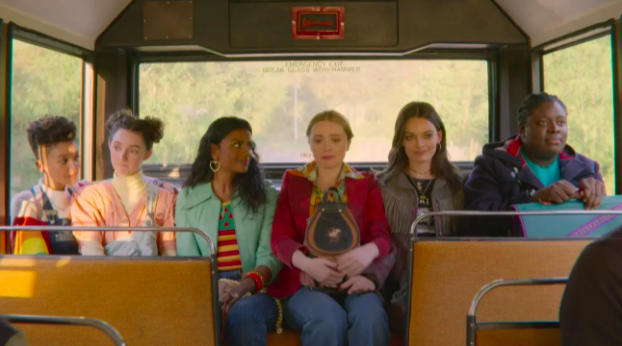Comedic and Raw: The Importance of Netflix's "Sex Education"
From depicting a range of socioeconomic backgrounds to vaginismus and anxiety, Netflix’s Sex Education has accurately touched upon the untouched. Spanning across three seasons — and a fourth confirmed — the show has managed to find a storyline that relates to corners of populations previously left alone. A no-fuss approach to having two mums, discovering sexuality, and highlighting female masturbation are only a few examples.
The premise of the show focuses on Secondary School student Otis Milburn as he finds himself in friendships, love, and more uniquely, giving out sexual advice, all stemming from his mum being a divorced sex therapist. What transpires is a comedic look at teenagers and adults finding out about themselves and each other in a heartfelt but brutally honest way. We see teenagers visiting a sexual health clinic, strangers becoming friends, open conversations surrounding feelings and intimacy, and the idea that healing isn’t linear.
Stand-outs
Diversity and Representation
Eric Effiong’s storyline consists of self-acceptance and discovery that I was unable to find among other characters. Although Milburn’s best friend, Eric is anything but a side character. Ncuti Gatwa who plays the character said, “It’s really nice to have a gay character, a Black gay character, be at the forefront of this story on a show like this that has the reach it does on Netflix.” In Season 3, Eric and his family head to Nigeria with the majority of the scenes shot in Lagos. This element of cultural representation is most often glorified or painted using a Western tinge, Sex Education took away the umbrella approach of Africa and in the words of Gatwa, “We’re showcasing this beautiful culture that doesn’t get shown a lot.”
Eric’s entrance into the Moordale High dance | Jon Hall/Netflix
As Season 3 was introduced, so was the show’s first non-binary character, Cal (Dua Saleh). The season focuses on navigating being non-binary in a world that to the smallest detail values cis-gendered people. An important example is something most wouldn’t think twice about: school uniform. The introduction of the uniform causes commotion due to fashion and expression, the idea is for everyone to be put in the same box. An idea that crumbles when the new Headmistress, Hope, fails to understand that not everyone is going to fit in her boxes. Cal finds it more comfortable to wear the “boys” uniform, facing backlash and reprimand from Hope who wants them to wear a “girls” uniform. By the end of the season, Cal forms a friendship with a fellow non-binary student, as a stark reminder that gender, even if contained in the same umbrella term, looks different for every individual. Further amplified by split female and male sexual health classes and separate girls and boy lines, it reveals the difficulty of navigating being non-binary in environments that favor otherwise.
Sexual Assault
Among representation and diversity, Sex Education should be heralded for its open and raw conversations about real issues. When character Aimee Gibbs gets silently masturbated on as she takes the bus, she’s hesitant to accept the situation for what it was: sexual assault. In a raw and emotive series, we watch Gibbs suppress the trauma and become someone who feels reluctant to be intimate with partner Steve. We see her grieve for the woman she used to be.
The girls support Aimee getting on the bus again | Netflix
It’s a calm approach to a significant story arc, an approach using sexual microaggression is one of genius and one of honesty. It’s the reality for many women and one Sex Education Executive Producer Jaimie Campbell was keen on portraying. When talking about how Aimee’s character felt in the moment, Campbell said, “It’s just like someone sneezing on me. The thing that really messes with her head is that she’s like, ‘He didn’t look like the type of person that would do that. He smiled at me!’” One in five women in the U.K. have experienced sexual assault. In a rare instance, media has been used to show the healing, grief, and acceptance of the event instead of using sexual assault such as rape, as a shock factor within a plotline and basing a woman’s identity around it.
Sexual Education and Health
In one Season 3 episode, Maeve Wiley takes a stand against the fearmongering female sex-ed class taking place. “We shouldn’t be shamed for having sexual desires. You make sex sound terrifying, but it doesn’t have to be. It can be fun and beautiful and teach you things about yourself and your body.” It’s not only adhering to the plot, it’s settling its grounds in reality. Many women are shamed for having sex, procuring sex, or not wanting to feel intimate. It’s unsettling that Wiley’s words are the basis of what is wrong with the sex education curriculum throughout Britain and potentially globally: sex is fearmongered for its potential consequences rather than the experience of intimacy and self-exploration.
To round off, as the show acts and narrates sensitive topics, the comedic element never trickles away. Masturbation montages, getting caught masturbating by a parent, and the revelation that no labia looks the same, it effortlessly takes what many would consider embarrassing and normalizes it, and rightfully so. A much-needed honest look into teenage sexuality, mental health, and the exploration of bodies.

